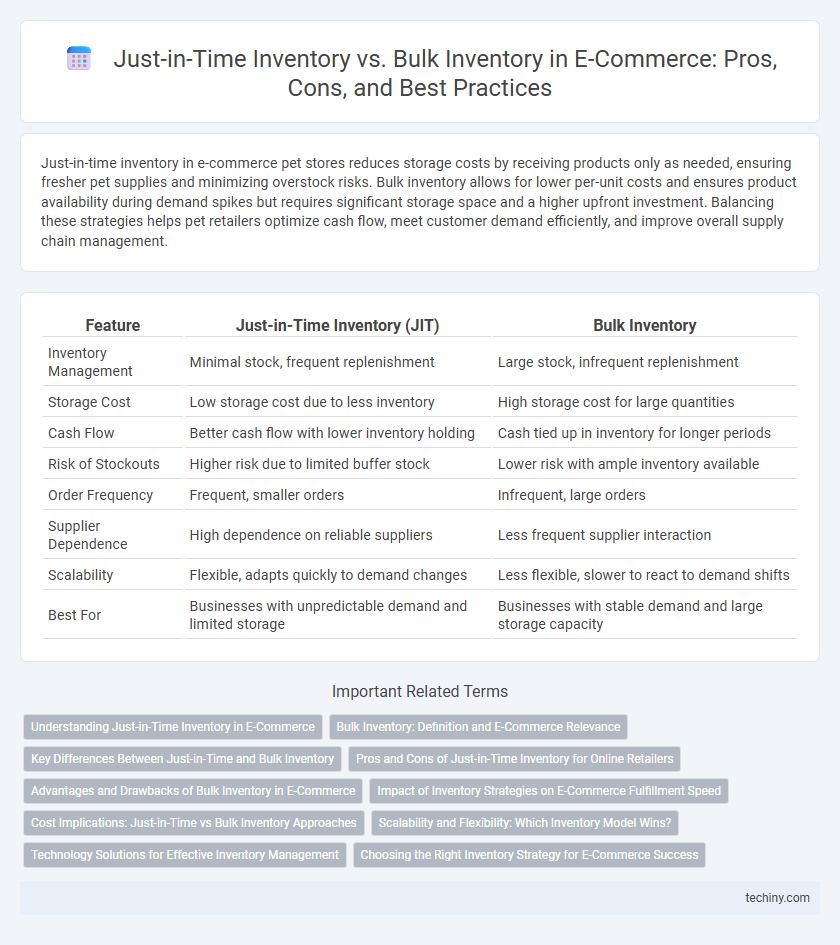Just-in-time inventory in e-commerce pet stores reduces storage costs by receiving products only as needed, ensuring fresher pet supplies and minimizing overstock risks. Bulk inventory allows for lower per-unit costs and ensures product availability during demand spikes but requires significant storage space and a higher upfront investment. Balancing these strategies helps pet retailers optimize cash flow, meet customer demand efficiently, and improve overall supply chain management.
Table of Comparison
| Feature | Just-in-Time Inventory (JIT) | Bulk Inventory |
|---|---|---|
| Inventory Management | Minimal stock, frequent replenishment | Large stock, infrequent replenishment |
| Storage Cost | Low storage cost due to less inventory | High storage cost for large quantities |
| Cash Flow | Better cash flow with lower inventory holding | Cash tied up in inventory for longer periods |
| Risk of Stockouts | Higher risk due to limited buffer stock | Lower risk with ample inventory available |
| Order Frequency | Frequent, smaller orders | Infrequent, large orders |
| Supplier Dependence | High dependence on reliable suppliers | Less frequent supplier interaction |
| Scalability | Flexible, adapts quickly to demand changes | Less flexible, slower to react to demand shifts |
| Best For | Businesses with unpredictable demand and limited storage | Businesses with stable demand and large storage capacity |
Understanding Just-in-Time Inventory in E-Commerce
Just-in-Time (JIT) inventory in e-commerce minimizes storage costs by receiving goods only as they are needed for sales, improving cash flow and reducing excess stock. This inventory strategy relies heavily on accurate demand forecasting and seamless supplier coordination to prevent stockouts and delays. Implementing JIT enhances operational efficiency and customer satisfaction by ensuring fresh inventory aligns closely with real-time consumer demand.
Bulk Inventory: Definition and E-Commerce Relevance
Bulk inventory involves purchasing and storing large quantities of products to meet anticipated demand, reducing per-unit costs and minimizing stockouts in e-commerce operations. This strategy supports high sales volumes and enables faster order fulfillment by maintaining ample product availability. E-commerce businesses leveraging bulk inventory benefit from economies of scale and improved supplier negotiation power, enhancing profitability and customer satisfaction.
Key Differences Between Just-in-Time and Bulk Inventory
Just-in-Time (JIT) inventory minimizes holding costs by receiving goods only as they are needed in the production process, ensuring lean stock levels and reducing waste. Bulk inventory involves purchasing and storing large quantities of products to meet anticipated demand, which can lead to higher storage costs but provides a buffer against supply chain disruptions. Key differences include cost management, with JIT focusing on cost efficiency through reduced inventory, while bulk inventory prioritizes availability and scalability during peak sales periods.
Pros and Cons of Just-in-Time Inventory for Online Retailers
Just-in-Time (JIT) inventory allows online retailers to reduce holding costs by receiving goods only as needed, minimizing storage expenses and decreasing waste from unsold products. The main downside includes vulnerability to supply chain disruptions, which can result in stockouts and delayed deliveries, negatively impacting customer satisfaction. JIT requires accurate demand forecasting and reliable suppliers to maintain inventory balance and ensure timely order fulfillment in e-commerce operations.
Advantages and Drawbacks of Bulk Inventory in E-Commerce
Bulk inventory in e-commerce offers advantages such as lower per-unit costs, improved supplier negotiation power, and reduced stockouts, supporting consistent customer satisfaction. However, it involves drawbacks including higher upfront capital investment, increased storage costs, and the risk of inventory obsolescence due to market demand fluctuations. Balancing bulk inventory requires efficient demand forecasting to avoid cash flow issues and excessive warehousing expenses.
Impact of Inventory Strategies on E-Commerce Fulfillment Speed
Just-in-Time (JIT) inventory significantly enhances e-commerce fulfillment speed by minimizing stock holding and allowing rapid response to customer orders, reducing lead times and storage costs. In contrast, bulk inventory ensures product availability but can slow down fulfillment due to complexities in managing large stock volumes and increasing warehouse handling time. E-commerce platforms leveraging JIT strategies often achieve faster shipping cycles and improved customer satisfaction through streamlined inventory flow and reduced order processing delays.
Cost Implications: Just-in-Time vs Bulk Inventory Approaches
Just-in-Time (JIT) inventory reduces carrying costs by minimizing stock levels, leading to lower storage expenses and less capital tied up in inventory. Bulk inventory purchasing often benefits from economies of scale and supplier discounts but incurs higher warehousing costs and risks of obsolescence. Balancing JIT's cost efficiency with bulk inventory's savings depends on demand variability and cash flow priorities in e-commerce operations.
Scalability and Flexibility: Which Inventory Model Wins?
Just-in-Time (JIT) inventory excels in scalability and flexibility by minimizing stock levels and responding swiftly to demand fluctuations, reducing holding costs and enhancing cash flow. Bulk inventory offers economies of scale but struggles with adapting to market changes quickly, leading to higher storage expenses and potential obsolescence. For e-commerce businesses prioritizing rapid growth and agile response to trends, JIT inventory typically outperforms bulk inventory in scalability and operational flexibility.
Technology Solutions for Effective Inventory Management
Technology solutions such as AI-powered demand forecasting and real-time inventory tracking play a crucial role in optimizing Just-in-Time inventory by reducing stockouts and minimizing carrying costs. Bulk inventory management benefits from ERP systems that integrate supplier data, automate reorder points, and enhance warehouse optimization to handle large stock volumes efficiently. Cloud-based platforms enable seamless coordination between suppliers and retailers, ensuring accurate stock levels and improving overall supply chain responsiveness.
Choosing the Right Inventory Strategy for E-Commerce Success
Choosing the right inventory strategy in e-commerce involves analyzing demand predictability and storage capabilities, with Just-in-Time inventory minimizing holding costs by receiving goods only as needed, and Bulk Inventory leveraging economies of scale to avoid stockouts during high demand periods. Data-driven forecasting tools and real-time sales analytics play a crucial role in optimizing inventory turnover rates and maintaining customer satisfaction through timely fulfillment. Balancing cost efficiency and responsiveness ensures better cash flow management, reduced obsolescence, and sustained competitive advantage in the online retail landscape.
Just-in-Time Inventory vs Bulk Inventory Infographic

 techiny.com
techiny.com